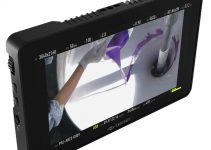If you’ve never heard of a NUC, then you may be surprised to find out what these devices are really capable of. NUC or Next Unit of Computing is a compact and lightweight computer created and sold by Intel which aims to pack computing performance in a form factor similar to a dense router.
Since the introduction of NUCs, people looking for computers for light to medium-intensity video editing have slowly begun to take notice of the computer speeds found in NUCs, all with a price and size that’s much lower in comparison to a DIY build.
Computer enthusiast and tech reviewer David Lee recently featured one of Intel’s latest NUCs – the Hades Canyon NUC – an unusual joint venture by Intel and competitor AMD to create a single yet efficient small form-factor computer.
It seems that this computer has been gaining a lot of attention in tech forums lately which undoubtedly has to do with the partnership between rivals Intel and AMD. Both sides have put down their respective blue and red flags to come together and combine their technologies into a single chip that delivers unparalleled performance in size smaller than a shoebox.
Inside of the matte-black sci-fi aesthetic exterior lies a chip that houses both an Intel i7 8809G Kaby Lake processor and an AMD Radeon RX Vega M GH GPU. Although considered an unusual pairing, the performance provided by the two processors impresses, indeed.
Keep in mind, though, that the unit reviewed in the video doesn’t come with any storage or memory. However, it’s pretty easy to install and upgrade these components on the fly. Inside the NUC, you have two DDR4 RAM slots that are upgradable to 32GB, in addition to two NVMe slots for fast storage.
In terms of I/O, the NUC sports five USB 3.0 Type A ports, a single USB 3.1 Type A port, 1 USB-C port, 2 Thunderbolt 3 Ports, 2 HDMI ports, 2 Ethernet Ports, 2 Mini Display Ports, a headphone/mic combo jack, and an audio/optical audio out jack.
Other integrated features include 802.11ac Wi-Fi, two Gigabit Ethernet ports, Bluetooth 4.2, and an SDXC card reader. For a computer with a volume of 1.2 liters, it’s surprising to see such a vast amount of inputs and outputs present in this device.
As far as performance goes, the NUC does seem to do reasonably well despite its ultra-portable form factor. With the Kaby Lake Processor, Cinebench R15 shows a single core score of 188 and a multi-core score of 863, which is a rather decent value, although it doesn’t surpass that of its desktop-class processor variants. As for the RX Vega M GH GPU, a Firestrike Graphics test delivers a score of 10,100, a result comparable to the NVIDIA GTX 1060 Max Q in a way.
When looking at real-world performance, Lee set the NUC to render out an eight-minute 5K project to a 4K H.264 video from Premiere Pro CC. It took approximately 20 minutes for the device to complete the task, which is somewhat slower than computers that use a desktop-class i7, but it’s still a decent result for a mini PC with such compact and lightweight form factor.
Lastly, thermal performance on the Hades Canyon NUC is actually a welcome improvement when compared to its predecessors. Although there may be slight thermal throttling at times, one aspect you won’t necessarily have to worry about is noise levels. In older models, NUCs tend to have significantly audible noise when under even light load. In this particular iteration, the mini PC stays relatively quiet on idle, light, or even max load.
Hades Canyon NUC Highlights
- 3.1 GHz Intel Core i7-8809G Quad-Core
- 2 x 2400 MHz DDR4 SO-DIMM Slots
- 2 x PCIe 3.0 x4 M.2 2242/2280 Slots
- AMD Radeon RX Vega M GH Graphics
- SD/SDHC/SDXC Media Card Reader
- Thunderbolt 3 | HDMI | Mini-DisplayPort
- 802.11ac Wi-Fi | Bluetooth 4.2
- VR-Ready
- Supports up to 6 Displays
- Windows Compatible
- Price: $999
It’s fair to say that while this computer is not a beast of an editing machine, it certainly does deliver favorable results for its price and size. While AMD and Intel’s partnership has proven successful through the Hades Canyon NUC project, it would be interesting to see how the combination of their graphics and computer processing technologies will develop, possibly increasing efficiency by transcending into the more prosumer-oriented markets.
[source: Dave Lee]
Order Link:
Intel NUC 8 VR NUC8I7HVK Gaming Mini PC
Disclaimer: As an Amazon Associate partner and participant in B&H and Adorama Affiliate programmes, we earn a small comission from each purchase made through the affiliate links listed above at no additional cost to you.
Claim your copy of DAVINCI RESOLVE - SIMPLIFIED COURSE with 50% off! Get Instant Access!





